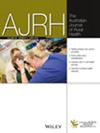The social determinants of Aboriginal and Torres Strait Islander adults who do not smoke in regional Australia
Abstract
Introduction
Commercial tobacco use was systematically embedded as a valuable commodity through colonisation that continues to be exploited for profit by the Tobacco Industry. There have been significant declines in current smoking prevalence among Aboriginal and Torres Strait Islander peoples 18 years and over, from 55% in 1994 to 43% in 2018–2019. This paper seeks to better understand smoke-free behaviours, and to systematically quantify associations between a range of SDOH and non-smoking/never-smoking among Aboriginal and Torres Strait Islander adults (≥18) living in regional Australia.
Objective
To explore the social determinants of health (SDOH) related to non- and never-smoking among Aboriginal and Torres Strait Islander peoples in regional Australia.
Design
Cross-sectional analysis of the NATSIHS, weighted to the Aboriginal and Torres Strait Islander adult population living in regional Australia, was conducted. Participants were characterised as people who were current smokers, never-smokers and non-smokers (ex- and never-smokers). The social determinants of health exposures related to socioeconomic position, well-being and access to healthcare.
Setting
Regional Australia is distinct from urban and remote areas, based on the ASGS Remoteness Structure (ABS) 2018–2019.
Participants
Aboriginal and Torres Strait Islander adults (≥18 years) who were selected, consented and asked questions about smoking in the National Aboriginal and Torres Strait Islander Health Survey (NATSIHS 2018/19).
Results
High income was associated with non-smoking (Prevalence Ratio [PR] = 2.07; 95% CI: 1.66–2.57) and never-smoking (PR = 2.02; 1.46–2.79), as was completing year 10 (non-smoking PR = 1.34; 1.12–1.61 and never-smoking PR = 1.56; 1.20–2.03). Better food security was associated with a higher prevalence of never-smoking (PR = 2.42; 1.48–3.98). Lower psychological distress scores were associated with non-smoking (PR = 1.30; 1.10–1.53) and never-smoking (PR = 1.56; 1.21–2.01). Never-smoking was more frequent in participants reporting no experiences of unfair treatment (PR = 1.59; 1.22–2.06). Having a usual healthcare provider was associated with non-smoking (PR = 1.38; 1.02–1.86). Positive exposure to the SDOH were associated with non- and never-smoking among Aboriginal and Torres Strait Islander adults in regional Australia. Structural and systemic changes to address the SDOH, including discrimination and racism, are expected to accelerate non-smoking behaviours and improve health outcomes for Aboriginal and Torres Strait Islander peoples.


 求助内容:
求助内容: 应助结果提醒方式:
应助结果提醒方式:


